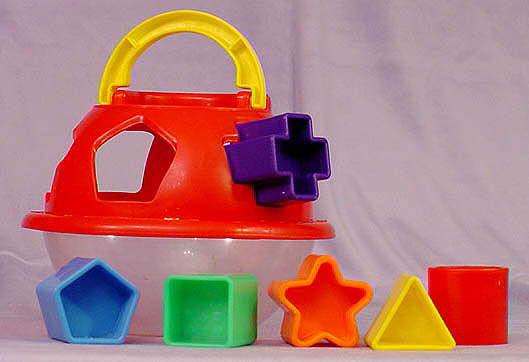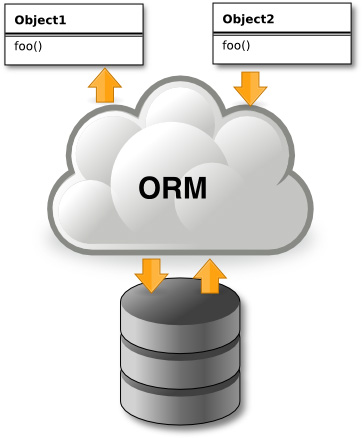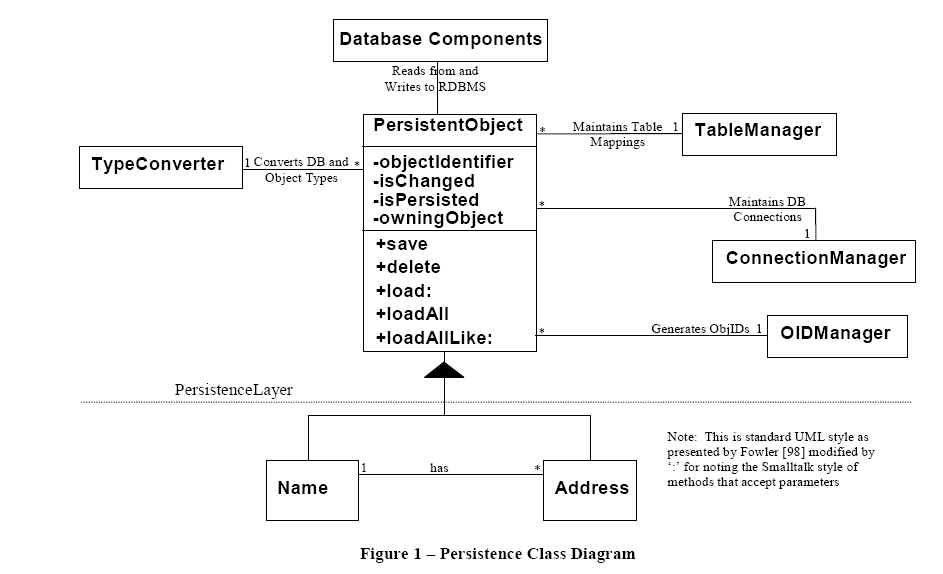CSC/ECE 517 Fall 2009/wiki3 12 obj to relational: Difference between revisions
(→CRUD) |
|||
| Line 170: | Line 170: | ||
==== Advantages & Disadvantages: ==== | ==== Advantages & Disadvantages: ==== | ||
Once the object model and your data model have been analyzed, the results can be implemented in | |||
CRUD providing a performance-optimized solution, thus isolating the developer from having to worry | |||
about performance details. Flexibility to retrieve data based on how many rows or what kind of data (dynamic, static, or somewhere in-between) is needed. It has a simple implementation to SAVE the data to, or back to, the database. The application developer does not have to determine whether to insert or update the object. However, CRUD can cause sub-optimal performance if the object model and data model have not been properly analyzed. This will make the job of the developer more difficult if they have to compensate another way. | |||
=== Type Conversion === | === Type Conversion === | ||
Revision as of 04:37, 18 November 2009
Patterns for mapping objects to relational databases
The Object-Relational Mismatch

Object-orientation and relational model are different paradigms of programming.[1] The object paradigm is based on building applications out of objects that have both data and behavior, whereas the relational paradigm is based on storing data. With the object paradigm, one traverses objects via their relationships whereas with the relational paradigm one duplicates data to join the rows in tables.[2] The difference between how object models work and relational databases is known as the “Object-Relational Impedance Mismatch”. This is just nerd-speak for “they are different”. In analogy, we could consider the example of the ball and shape game. It's the same thing; you can’t fit a square in a triangle hole.[10]
One way to avoid the impedance mismatch between objects and relations is to use an object-oriented database. However, systems often need to store objects in a relational database. Sometimes a system needs relational calculus or the maturity of a relational database. Other times the corporate policy is to use a relational database rather than an object-oriented database. Whatever the reason, a system that stores objects in a relational database needs to provide a design that reduces the impedance mismatch.[5] One of the secrets of success for mapping objects to relational databases is to understand both paradigms, and their differences, and then make intelligent trade offs based on that knowledge.[2] An application that maps between the two paradigms needs to be designed with respect to performance, maintainability and cost to name just a few requirements.[4]

Persistence frameworks were designed to reduce the amount of work needed to develop an object-oriented system that stores data in a relational database. For this reason, this framework area is often also referred to as object-relational mapping or ORM (see the below Figure). The goal of a persistence framework is to automatically map objects to and from a database seamlessly so that information can be quickly and easily retrieved in object format, and then subsequently stored in its relational structure. This aids in system development and maintenance greatly. The mundane details of writing one's own create, read, update, and delete functions are taken care of, so one can concentrate on designing and building the application.[11]
Patterns
This page describes patterns for mapping objects to relations.
Persistence Layer
Motivation:
If one builds a large object-oriented business system that stores objects in a relational database, one can spend a lot of time dealing with the problems of making one's objects persistent. Also, every programmer working on the system has to know SQL and the code can become tied to the database. It can be a lot of work to convert the system from using Microsoft Access to using DB2, or even adding a few variables to an object. One needs to separate one's domain knowledge from knowledge of how objects are stored in a database to protect developers from these types of changes. The problem is how to save objects in a non object-oriented storage mechanism such as a relational database with the developers not having to know the exact implementation.
Solution:
The solution is to provide a Persistence Layer that can populate objects from a data storage source and save their data back to the data storage source. This layer should hide the developer from the details of storing objects. All persistent objects use the standard interface of the Persistence Layer. If the data storage mechanism changes, only the Persistence Layer needs to be changed. For example, the corporate direction may be to start using Oracle rather than DB2 and then switch in midstream. The system needs to know how to store each object and to load it. Sometimes an object is stored in multiple databases over multiple media. An object that is part of a more complex object needs to keep track of which object it is a part; this is called the owning object. This owning object idea makes it easier to write complex queries. Therefore it is important for the Persistence Layer to provide a means to uniquely identify each object and its parent.
Example Implementation:
The figure shown below is a UML class diagram for an implementation of Persistent Layer which map domain objects to a relational database. Note that in this example, domain objects that need to be persisted are subclasses of the PersistentObject. The PersistentObject provides for the interface to the Persistence Layer. The PersistentObject interacts with the Table Manager, the Connection Manger and the OID Manager. Thus, the PersistentObject is the central hub for any information the domain object requires but does not contain in the instance.
Records can be read in three ways:
- a single row (PersistentObject>>load:),
- all records (PersistentObject>>loadAll),
- or all that match a specific criteria (PersistentObject>>loadAllLike:).
The specific criteria is provided by creating a new instance of the object to load with the attributes set needed to find a match. This functions with the PersistentObject>>load: and PersistentObject>>loadAllLike: methods. The PersistentObject>>loadAll method is useful for retrieving reference data from tables where you want to populate a selection list or drop down list.
The following is example code from the PersistentObject described above.
Protocol for Public Interface PersistentObject (instance)
load "Answer a single instance of a subclasse of PersistentObjects that matchs self.” | oc | oc := self loadAllLike. ^oc isEmpty ifTrue: [nil] ifFalse: [oc first]
loadAllLike "Answer a collection of subclasses of PersistentObjects that match self. The selectionClause method in the Domain object is called to prepare the WHERE clause for the read method in the PersistentObject" ^self class read: ( self selectionClause )
save “Saves self to the database wrapped in a transaction.” self class beginTransaction. self saveAsTransaction. self class endTransaction.
delete “Deletes self from the database wrapped in a transaction.” self class beginTransaction. self deleteAsTransaction. self class endTransaction.
Protocol for Public Interface PersistentObject (class)
loadAll "Answer a collection of ALL my instances from the database." ^self read: nil.
Advantages & Disadvantages:
An important benefit of isolating the application developer from the details of how an object saves itself is that it makes it easier to implement domain objects. Thus, it is less work to evolve the domain model. By encapsulating the functionality of the object persistence mechanism, a developer will effectively be hidden from the details of saving the object. However, a Persistent Layer can make it complicated and sometimes difficult to do operations that might be easy to write in SQL Code. Also, optimizations can be difficult in a Persistent Layer.
CRUD
Motivation:
Consider the example of a Patient class with components of class Name and Address. When one reads a Patient, one must also read Name and Address. Writing out a Patient will probably cause writing Name and Address objects to the database. The question that arises here is should they all have the same interface for reading and writing. Maybe some object requires a different interface to the database. Can we give them all the same interface? If so, what should it be?
Any persisted object needs operations to read from and write to the database. Values being persisted may also be for newly created objects. Sometimes, objects may need to be deleted from the persistence storage. Therefore, anytime an object needs to be persistent, it is important to provide, at a minimum, create, read, update, and delete operations. The question (and the problem) is what minimal operations are needed for a persistent object.
Solution:
The solution is to provide the basic CRUD (create, read, update, and delete) operations for persistent objects. Other operations that may be needed are loadAllLike: or loadAll. The important point is to provide at least enough to instantiate objects from a database and store newly created or changed objects. If all domain objects have a common PersistentObject superclass, then this class can define the CRUD operations and all domain objects can inherit them. Subclasses can override them if necessary to increase performance. Thus, each domain object must make available a description of the SQL code necessary for accessing the database available for the CRUD operations. Thus CRUD works closely with a SQL Code Description for insuring that the operations are sufficient for persisting domain objects.
Example Implementation:
The PersistentObject described above provides the standard interface to the basic set of operations for mapping the objects to the database; save, load, etc. These methods are inherited from the PersistentObject which access the CRUD operations. Some of these CRUD methods may need to be overwritten by the domain object. The updateRowSql and the insertRowSql are described in the SQL Code Description pattern below.
Protocol for CRUD PersistentObject (class)
This method takes a WHERE clause as an agent, and returns a collectin of objects that correspond to the rows that matches the WHERE clause.
read: aSearchString
”Returns a collection of instances populated from the database.”
| aCollection |
aCollection := OrderedCollection new.
(self resultSet: aSearchString)
do: [:aRow | aCollection add: (self new initialize: aRow)].
^aCollection
Protocol for Persistence Layer PersistentObject (instance)
These methods save or delete objects from the database. These methods make the decisions of what kind of SQL statements (insert, update, or delete) based on the object’s values. Once the decisions have been made the SQL statement is then fired to the database.
saveAsTransaction "Save self to the database." self isPersisted ifTrue: [self update] ifFalse: [self create]. self makeClean
update "Updates aggregate classes then updates self to the database" self saveComponentIfDirty. self basicUpdate
create "Inserts aggregate classes then inserts self to the database." self saveComponentIfDirty. self basicCreate
basicCreate "Fires the insert SQL statement to the database" self class executeSql: self insertRowSql. isPersisted := true
basicUpdate "Fires the update SQL statement to the database." (self isKindOf: AbstractProxy) ifTrue: [^nil]. isChanged ifTrue: [self class executeSql: self updateRowSql]
deleteAsTransaction "Delete self from the database.." self isPersisted ifTrue: [self basicDelete]. ^nil
basicDelete
"Fires the delete SQL statement to the database."
self class
executeSql:('DELETE FROM ',self class table,' WHERE ID_OBJ=',
(self objectIdentifier printString)).
Advantages & Disadvantages:
Once the object model and your data model have been analyzed, the results can be implemented in CRUD providing a performance-optimized solution, thus isolating the developer from having to worry about performance details. Flexibility to retrieve data based on how many rows or what kind of data (dynamic, static, or somewhere in-between) is needed. It has a simple implementation to SAVE the data to, or back to, the database. The application developer does not have to determine whether to insert or update the object. However, CRUD can cause sub-optimal performance if the object model and data model have not been properly analyzed. This will make the job of the developer more difficult if they have to compensate another way.
Type Conversion
Motivation:
Solution:
Example Implementation:
Advantages & Disadvantages:
Change Manager
Motivation:
Solution:
Example Implementation:
Advantages & Disadvantages:
Transaction Manager
Motivation:
Solution:
Example Implementation:
Advantages & Disadvantages:
Connection Manager
Motivation:
Solution:
Example Implementation:
Advantages & Disadvantages:
Table Manager
Motivation:
Solution:
Example Implementation:
Advantages & Disadvantages:
Conclusion
The concurrency patterns discussed above involve coordinating concurrent operations. They address two types of problems:[5]
Shared resources - When concurrent operations access the same data or another type of shared resource, operations may interfere with each other if they access the resource at the same time. To ensure that operations on shared resources execute correctly, the operations must be sufficiently constrained to access their shared resource one at a time. However, if the operations are overly constrained, then they may deadlock and not be able to finish executing.
Sequence of operations - If operations are constrained to access a shared resource one at a time, it may be necessary to ensure that they access the shared resource in a particular order. For example, an object cannot be removed from a data structure before it is added to the data structure.
See Also
- Monitor Object
- Active Object
- Thread pool pattern
- Reactor patter
- Double Buffering
- Scheduler
- Asynchronous Processing
References
[1] Wolfgang Keller, Mapping Objects to Tables - A Pattern Language http://www.objectarchitects.de/ObjectArchitects/papers/Published/ZippedPapers/mappings04.pdf
[2] Scott W. Ambler, President, Ronin International, Mapping Objects To Relational Databases http://www.crionics.com/products/opensource/faq/docs/mappingObjects.pdf
[3] Scott W. Ambler, Mapping Objects to Relational Databases: O/R Mapping In Detail http://www.agiledata.org/essays/mappingObjects.html
[4] Wolfgang Keller, Object/Relational Access Layers - A Roadmap, Missing Links and More Patterns http://citeseer.ist.psu.edu/4328.html
[5] Joseph W. Yoder, Ralph E. Johnson, Quince D. Wilson, Connecting Business Objects to Relational Databases http://citeseerx.ist.psu.edu/viewdoc/download?doi=10.1.1.34.7703&rep=rep1&type=pdf
[6] Michael R. Blaha, William J. Premerlani and James E. Rumbaugh, Relational Database Design using an Object-Oriented Methodology http://www.sims.monash.edu.au/subjects/ims2501/seminars/oomodelling.pdf
[7] http://www.cetus-links.org/oo_db_systems_3.html
[8] http://www.ibm.com/developerworks/library/ws-mapping-to-rdb/
[10] http://cantgrokwontgrok.blogspot.com/2009/03/tech-day-1-nhibernate.html
[11] http://www.adobe.com/newsletters/edge/october2008/articles/article2/index.html?trackingid=DWZST
[12] Joseph W. Yoder, Patterns for Making your Business Objects Persistent in a Relational Database http://www.joeyoder.com/Research/objectmappings/mappingobjectstordbms/ppframe.htm
